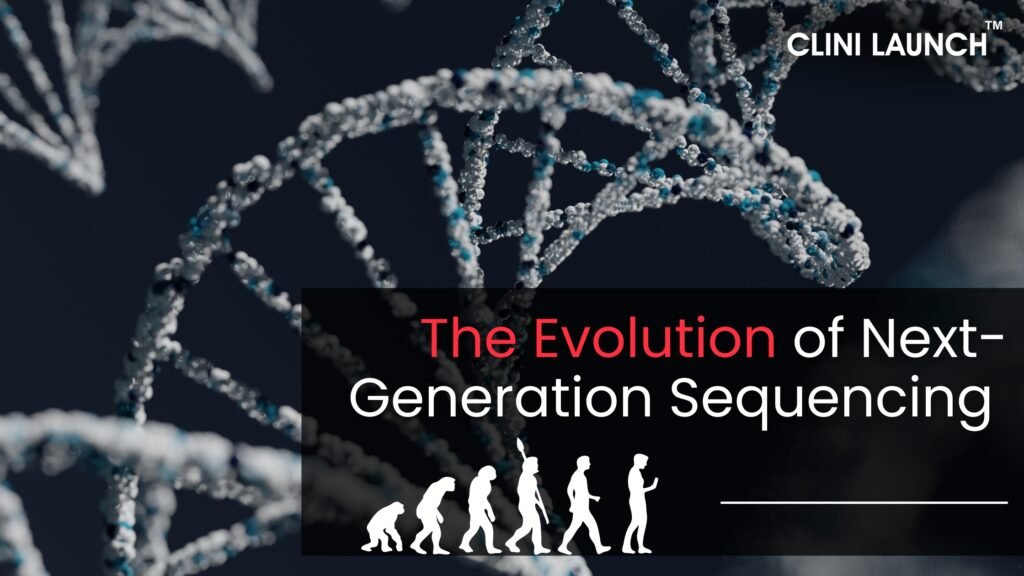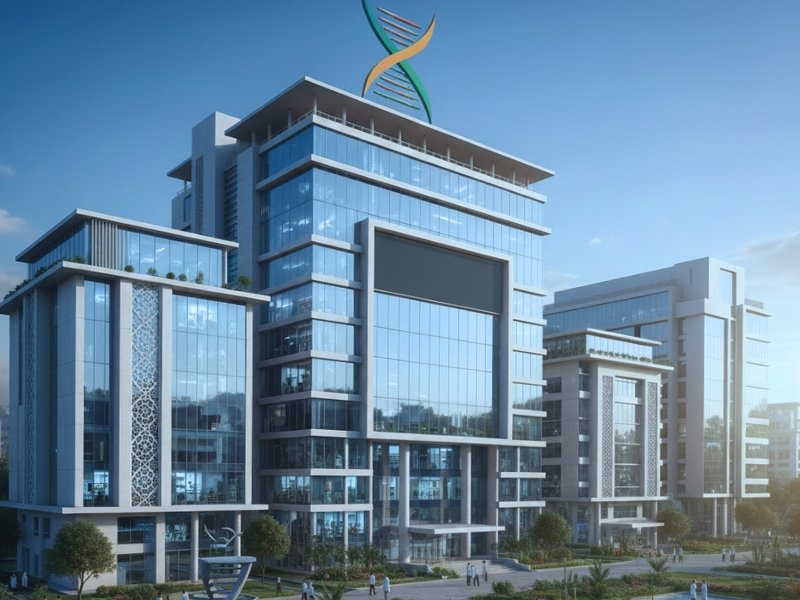The next generation sequencing is projected to reach $97.8 billion by 2035 reported by Allied Market Research with 18.3% compound annual growth rate from 2024. With the increase in genetic disorder and cancer incidences in the global market, it is emphasized that there is an urgent need for advanced genomics technologies.
NGS next generation sequencing is a high-throughput DNA sequencing technology allowing cost-effective sequencing of DNA or RNA. It enables the study of genetic variations and biological phenomena. This leads to advancements in research and clinical applications such as disease diagnosis and personalized medicine.
Traditional Sanger sequencing, while ground-breaking in its time, was limited by its throughput and cost. NGS, also known as New Generation Sequencing or Next Generation DNA sequencing, overcomes these limitations by massively parallel sequencing of millions of DNA fragments simultaneously. This allows for rapid and cost-effective sequencing of entire genomes, transcriptomes, or targeted gene panels.
NGS breaks down DNA or RNA into smaller fragments, attaches adapter sequences, and then amplifies and sequences these fragments in parallel. This high-throughput approach generates vast amounts of data, providing a comprehensive view of genetics.
Enrol Now: PG Diploma in Bioinformatics
The History of Next Generation Sequencing Technologies
The groundbreaking discovery of the DNA double helix structure, a cornerstone of modern biology, is credited to James Watson and Francis Crick in 1953. Their work, for which they received the 1962 Nobel Prize, was significantly informed by the crucial X-ray crystallography data provided by Rosalind Franklin. Franklin’s contributions, essential to understanding DNA’s molecular structure, were initially underappreciated, leading to her being referred to as ‘the dark lady of DNA’. Later in 1968, Robert Holley further advanced the field by becoming the first to sequence and RNA molecule. Together, these pivotal discoveries laid the foundation for the subsequent development of RNA sequencing technologies.
Following are the most important defining moments for genomic DNA sequencing:
- 1972: Paul Berg‘s pioneering work established the foundational technique for isolating specific DNA segments, which was crucial for the emergence of contemporary genetic engineering. Prior to his breakthrough, scientists were limited to studying the DNA of viruses and phages.
- 1973: Walter Gilbert pioneered DNA sequencing by publishing the first nucleotide sequence, a 24-base-pair segment of the lac operator.
- 1977: Frederick Sanger achieved a landmark in genomics by determining the complete DNA sequence of the bacteriophage phi X174, a feat that marked the first fully sequenced genome. He also innovated ‘chain-termination sequencing’, a method that revolutionized DNA analysis.
- 1977: Walter Gilbert developed the chemical degradation method for DNA sequencing.
- 1986: A pivotal advancement in genomics occurred when Leroy Hood, working at Caltech, unveiled the initial semi-automated DNA sequence, a device that significantly propelled the ability to map and sequence genetic information.
- 1987: The ABI370, developed and sold by Applied Biosystems in the United States, revolutionized genetic research as the first automated DNA sequence, playing a crucial role in projects like the Human Genome Project.
- 1990: In a landmark collaborative effort, the Human Genome Project was launched, uniting scientists from the United States, United Kingdom, France, Germany, Japan, China, and India, with an anticipated duration of 15 years.
- 1998: Eric Kawashima, Laurent Farinelli, and Pascal Mayer, working at Glaxo Wellcome’s Geneva Biomedical Research Institute, pioneered a method for nucleic acid amplification, a key advancement for Next-Generation Sequencing (NGS).
- 2000: The Human Genome Project achieved a preliminary version of the complete human genome, largely thanks to breakthroughs in genomics, particularly in the analysis of DNA sequences.
The Evolution of Next-Generation Sequencing

The advent of Next-Generation Sequencing (NGS) is the early 2000s advanced DNA sequencing. Based on the traditional Sanger method, NGS offered an unprecedented combination of high-throughput data generation, speed, cost-effectiveness, and accuracy, fundamentally expanding the scope of genomic research.
Following is the key revolutionary moment of next-generation sequencing:
- 2000: A pioneering step in next-generation sequencing (NGS) was taken by Lynx Therapeutics, who introduced Massively Parallel Signature Sequencing (MPSS). This foundational technology, later integrated into Illumina’s portfolio, marked the dawn of a new era in genomics.
- 2004: The landscape of DNA sequencing underwent a seismic shift with the commercialization of the Roche GS20 by 454 Life Sciences. This pyrosequencing platform, the first NGS system to reach the market, delivered an unprecedented 20 million base pairs, fundamentally transforming sequencing capabilities.
- 2008: The power of NGS was vividly demonstrated with the publication of the first study detailing the sequencing of a complete human genome. James Watson received his personal genome on a hard drive, a feat that cost approximately $1 million. This event heralded the widespread adoption of NGS for individual genome sequencing.
- 2014: Illumina achieved a significant milestone by launching the HiSeq X Ten Sequencer, claiming to have achieved the $1,000 genome. However, reaching this price point required substantial initial investments in the tens of millions.
- 2014: Illumina’s dominance in the DNA sequencing sector became undeniable, with the company controlling 70% of the sequencer market and contributing to over 90% of global DNA data production, effectively establishing a near-monopoly.
- 2018: Veritas Genetics made waves by offering whole genome sequencing for an astonishing $199, albeit to a limited group of 1,000 customers, showcasing the rapidly decreasing costs of genomic analysis.
- 2019: The National Human Genome Research Institute reported that the cost of sequencing a full human genome had fallen to $942, surpassing the predicted rate of cost reduction based on Moore’s Law.
- 2022: Ultima Genomics disrupted the short-read sequencing market by announcing the $100 genome, a remarkable achievement accomplished just eight years after Illumina’s HiSeq X Ten Sequencer breakthrough in 2014.
- 2022: In response to Ultima’s announcement, Illumina introduced the NovaSeq X Series, a platform designed to produce over 20,000 whole genomes annually, demonstrating the ongoing competitive innovation in the field.
Platforms or Tools for New Generations Sequencing
There are several platforms that exist within New Generation Sequencing Technologies, each with its unique strengths and applications.
Here are some of the examples that include:
Illumina Sequencing
Illumina sequencing is a widely used next-generation sequencing (NGS) technology determines DNA sequences by tracking the addition of labelled nucleotides as the DNA chain is copied in a massively parallel fashion, using a method called sequencing by synthesis (SBS).
Oxford Nanopore Sequencing
Oxford Nanopore sequencing is a technology that sequences DNA and RNA in real-time. It uses nanopores, which are tiny holes in a membrane, to analyze the current disruption caused by passing molecules.
454 pyrosequencing
454 pyrosequencing, a next-generation sequencing technology developed by Roche, utilizes a sequencing-by-synthesis approach where DNA fragments are amplified on beads, then sequenced by detecting the release of pyrophosphate (PPi) upon nucleotide incorporation.
Ion Torrent Sequencing
Ion Torrent Sequencing is a next-generation sequencing (NGS) technology that uses semiconductor chips to detect hydrogen ions released during DNA polymerization, enabling rapid and accurate DNA sequencing for various applications.
Pacific Biosciences (PacBio) Sequencing
Imagine DNA polymerase, actively building a new strand of DNA. Each building block, a nucleotide (dNTP), carries a unique fluorescent beacon, a distinct color reveals its identity as it is added to the growing chain. This visual tracking of nucleotide incorporation is the essence of the process.
Next Generation Sequencing Analysis to Decode

Next-generation sequencing analysis involves the use of high-throughput sequencing technologies to rapidly analyse large amounts of DNA or RNA. It enables researchers to study genomes and identify genetic variations. The raw data generated by NGS platforms is just the beginning. It involves a series of computational steps to process, analyse and interpret the sequencing data.
The journey from biological sample to meaningful data in next-generation sequencing (NGS) analysis unfolds in four distinct phases.
Library Preparation
Library preparation transforms the starting DNA or RNA into a sequence able form. This meticulous process involves fragmenting the nucleic acid, attaching adapter sequences for platform binding and identification, and amplifying the fragments to generate sufficient signal. Essentially, it’s the crucial step of preparing the genetic material for the high-throughput sequencing process that follows.
Sequencing
Sequencing itself takes place, where the prepared library is subjected to the core chemistry of the NGS platform. Modern systems often employ sequencing-by-synthesis, where DNA strands are built one base at a time, and each incorporated base is detected through fluorescent or other signals. This allows for the simultaneous sequencing of millions of fragments, generating a vast amount of raw data.
Data Analysis (Primary Analysis)
The initial processing of this raw data falls under primary data analysis. Here, the detected signals are translated into actual DNA sequences (base calling), and the quality of the sequencing data is assessed. Low-quality reads are filtered out, leaving a set of reliable sequence reads. This stage is critical for ensuring the accuracy of downstream analyses.
Data Analysis (Secondary/Tertiary Analysis)
Secondary and tertiary data analysis focuses on extracting biological insights from the processed sequence data. This involves aligning the reads to a reference genome, identifying genetic variations, quantifying gene expression, or performing other analyses depending on the experimental goal. This is where researchers answer their specific biological questions, making sense of the vast amounts of sequencing data generated.
Overall, bioinformatics tools and pipelines are essential for handling the massive datasets generated by next generation sequencing. These tools enable researchers to extract meaningful biological insights from the complex sequencing data.
Common Applications of Next Generation Sequencing

Next generation sequencing has revolutionized various fields. It includes:
Genomics
Through next generation sequencing, researchers gain the power to simultaneously examine a vast number of gene i.e., ranging from hundreds to thousands across multiple samples. This technology’s strength lies in its ability to uncover and analyse a diverse spectrum of genomic features within a single experiment. Pinpointing individual base changes in single nucleotide variants (SNVs) to specifically detect larger alternatives like copy number variations, structural rearrangements, and even RNA fusions, next generation sequencing provides a comprehensive view of the genome.
Transcriptomics
With the ability to analyse a set of complete RNA transcripts or the transcriptome revolutionizing numerous scientific domains. Transcriptomics pinpoints disease markers and accelerate pharmaceutical development explaining the complexities of organismal development while deciphering plant responses to environmental challenges. It provides a powerful lens for biological investigation.
Cancer Research
Next generation sequencing revolutionized cancer genomics. It provides and unprecedented level of detail into the genetic and epigenetic alterations driving malignancy. This technological lead has not only deepened our understanding of cancer’s fundamentals biology but also ushered in a new era of personalized medicine, transforming how we diagnose and treat cancer patients.
Infectious Disease
Next-generation sequencing is revolutionizing infectious disease diagnostics, offering rapid and accurate pathogen identification, detection of antimicrobial resistance, and insights into disease transmission and virulence, surpassing traditional methods.
Personalized Medicine
Using next-generation sequencing for personalized medicine enables a rapid and accurate sequencing of DNA, leading to faster and more precise diagnoses, targeted therapies, and personalized treatments plans based on individual genetic profiles.
Agriculture
Next-generation sequencing is revolutionizing agriculture by enabling rapid and cost-effective analysis of plant and animal genomes, facilitating the identification of genes and markers for desirable traits while also accelerating crops and livestock improvement. It is useful in improving crop yields and developing disease-resistant varieties.
The Scope of Next-Generation Sequencing
As next-generation sequencing technologies continue to rise, we can expect even greater advancements in throughput with accuracy and cost-effective methods. These methodologies will help researchers further expand the applications of NGS and it will help in acceleration of discoveries in various fields. The future scope of biological and medical research is intimately tied to the ongoing advancements within next-generation sequencing technologies, and the field of next generation sequencing analysis. As the technologies will improve, it will provide event more valuable analysis and insights useful for further weakening the complexities of life.
About Clini Launch
Want to learn computational methods to analyse biological data? You can get deep insights with next-generation DNA sequencing, structural bioinformatics, and genomic data analysis with the best Post Graduate Diploma in Bioinformatics course online/offline offered by Clini Launch. Let’s kick start your career with bioinformatics training program and gain in-depth industry insights, hands-on practical learning experience and 100% placement support with real-world applications.
Let’s empower you with vital computational tools to analyse biological data, merging technical proficiency with practical training. Prepare for certifications and pursue a rewarding career in the field of bioinformatics. Join Clini Launch.
References
2025 and Beyond: The Future of Genomic Data Analysis and Innovations in Genomics Services
Next-Generation Sequencing Technology: Current Trends and Advancements
https://www.mdpi.com/2079-7737/12/7/997
Next generation sequencing technology: Advances and applications
https://www.sciencedirect.com/science/article/pii/S092544391400180X





